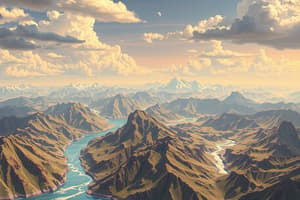Podcast
Questions and Answers
Which term describes the theory that explained the movement of tectonic plates due to convection currents?
Which term describes the theory that explained the movement of tectonic plates due to convection currents?
- Plate Tectonic Theory (correct)
- Seismic Theory
- Geological History Theory
- Continental Drift Theory
What are the three types of plate boundaries?
What are the three types of plate boundaries?
- Transform, Divergent, Convection
- Convergent, Divergent, Transform (correct)
- Divergent, Contraction, Convergent
- Convergent, Subduction, Divergent
What geological event is primarily caused when tectonic plates move adjacent to each other?
What geological event is primarily caused when tectonic plates move adjacent to each other?
- Volcanic eruption
- Earthquake (correct)
- Mountain formation
- Tsunami
What is the primary characteristic of the Pacific Ring of Fire?
What is the primary characteristic of the Pacific Ring of Fire?
Who is credited with the development of the Continental Drift Theory?
Who is credited with the development of the Continental Drift Theory?
What triggers volcanic activity according to geological principles?
What triggers volcanic activity according to geological principles?
Which geological layer is located between the crust and the core of the Earth?
Which geological layer is located between the crust and the core of the Earth?
What happens at convergent plate boundaries?
What happens at convergent plate boundaries?
What primarily causes Hot Spots?
What primarily causes Hot Spots?
Which type of rock is formed from the accumulation of sediments?
Which type of rock is formed from the accumulation of sediments?
What process involves the breakdown of rocks but does not relocate the debris?
What process involves the breakdown of rocks but does not relocate the debris?
How many landform regions does Canada have?
How many landform regions does Canada have?
Which factor is NOT part of the LOWERN acronym that affects climate?
Which factor is NOT part of the LOWERN acronym that affects climate?
What is the primary characteristic of maritime climate?
What is the primary characteristic of maritime climate?
Which equation correctly calculates the temperature range?
Which equation correctly calculates the temperature range?
In which climate region does the southeastern part of Canada fall?
In which climate region does the southeastern part of Canada fall?
Flashcards are hidden until you start studying
Study Notes
Earth Structure & Geological History
- A theory is an explanation supported by evidence and accepted by the scientific community.
- Earth's four geological eras: Precambrian, Paleozoic, Mesozoic, and Cenozoic.
- Earth's structure: Crust, Mantle, and Core.
Plate Tectonics & Continental Drift
- Alfred Wegener proposed the theory of continental drift, suggesting a supercontinent called Pangaea.
- Tuzo Wilson explained plate tectonics through his work on convection currents.
- Plate tectonic theory describes the movement of tectonic plates on Earth's surface.
- Convection currents are caused by magma rising from the core, creating circulation within the mantle.
- Plate boundaries are where tectonic plates meet:
- Convergent boundaries (plates collide)
- Divergent boundaries (plates move apart)
- Transform boundaries (plates slide past each other)
Earthquakes, Volcanoes, & Tsunamis
- Earthquakes are caused by the sudden release of energy along fault lines where tectonic plates move.
- Volcanic activity results from magma rising to the surface, creating hotspots.
- The Pacific Ring of Fire is a zone of high earthquake and volcanic activity around the Pacific Ocean.
Rock Cycle, Weathering/Erosion/Deposition, Canadian Landform Regions
- Rock types: Igneous, Sedimentary, and Metamorphic
- Weathering, Erosion, and Deposition (WED):
- Weathering breaks down rocks.
- Erosion transports weathered material.
- Deposition settles weathered material, forming new rock.
- Canada's 8 landform regions:
- Canadian Shield
- Western Cordillera
- Appalachian Mountains
- Innuitian Mountains
- St. Lawrence Lowlands
- Interior Plains
- Arctic Hudson Bay Lowlands
- Hudson Bay Lowlands
Climate Regions & LOWERN
- Weather is short-term atmospheric conditions, while climate is long-term patterns.
- Canada has 7 climate regions.
- Factors affecting climate (LOWERN):
- Latitude
- Ocean currents
- Wind masses
- Elevation
- Relief
- Nearness to water
Climate Graphs
- Climate graphs display both temperature and precipitation data over time.
- Average annual temperature is calculated by averaging monthly temperatures.
- Temperature range is the difference between the highest and lowest monthly temperatures.
- Maritime climates have smaller temperature ranges (less than 25°C).
- Continental climates have larger temperature ranges.
- Total precipitation is calculated by adding up monthly precipitation amounts.
- Maritime climates receive more precipitation (over 1000 mm).
- Continental climates receive less precipitation.
Studying That Suits You
Use AI to generate personalized quizzes and flashcards to suit your learning preferences.




